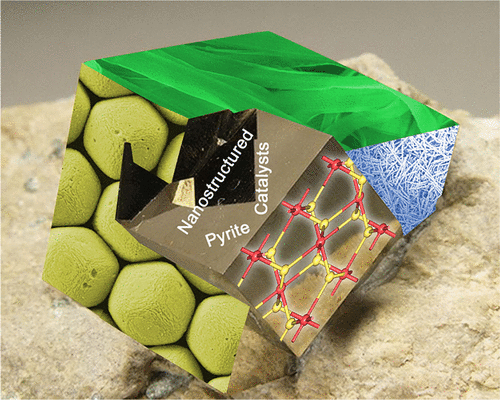当前位置:
X-MOL 学术
›
Acc. Chem. Res.
›
论文详情
Our official English website, www.x-mol.net, welcomes your
feedback! (Note: you will need to create a separate account there.)
Pyrite-Type Nanomaterials for Advanced Electrocatalysis
Accounts of Chemical Research ( IF 16.4 ) Pub Date : 2017-08-21 00:00:00 , DOI: 10.1021/acs.accounts.7b00187 Min-Rui Gao 1 , Ya-Rong Zheng 1 , Jun Jiang 1 , Shu-Hong Yu 1
Accounts of Chemical Research ( IF 16.4 ) Pub Date : 2017-08-21 00:00:00 , DOI: 10.1021/acs.accounts.7b00187 Min-Rui Gao 1 , Ya-Rong Zheng 1 , Jun Jiang 1 , Shu-Hong Yu 1
Affiliation

|
Since being proposed by John Bockris in 1970, hydrogen economy has emerged as a very promising alternative to the current hydrocarbon economy. Access to reliable and affordable hydrogen economy, however, requires cost-effective and highly efficient electrocatalytic materials that replace noble metals (e.g., Pt, Ir, Ru) to negotiate electrode processes such as oxygen evolution reaction (OER), hydrogen evolution reaction (HER), and oxygen reduction reaction (ORR). Although substantial advances in the development of inexpensive catalysts, successful deployment of these materials in fuel cells and electrolyzers will depend on their improved activity and robustness. Recent research has demonstrated that the nanostructuring of Earth-abundant minerals provides access to newly advanced energy materials, particularly for nanostructured pyrites, which are attracting great interest. Crystalline pyrites commonly contain the characteristic dianion units and have cations occurring in octahedral coordination—whose generalized formula is MX2, where M can be transition metal of groups 8–12 and X is a chalcogen. The diversity of pyrites that are accessible and their versatile and tunable properties make them attractive for a wide range of applications from photovoltaics to energy storage and electrocatalysis. Pyrite-type structures can be further extended to their ternary analogues, for example, CoAsS (cobaltite), NiAsS (gersdorffite), NiSbS (ullmannite), CoPS, and many others. Moreover, improved properties of pyrites can be realized through grafting them with promoter objects (e.g., metal oxides, metal chalcogenides, noble metals, and carbons), which bring favorable interfaces and structural and electronic modulations, thus leading to performance gains. In recent years, research on the synthesis of pyrite nanomaterials and on related structure understanding has dramatically advanced their applications, which offers new perspectives in the search for efficient and robust electrocatalysts, yet a focused review that concentrates the critical developments is still missing.
中文翻译:

用于高级电催化的黄铁矿型纳米材料
自1970年由约翰·博克里斯(John Bockris)提出以来,氢经济已成为当前碳氢经济的非常有前途的替代方案。但是,要获得可靠且负担得起的氢气经济性,就需要经济高效的高效电催化材料来替代贵金属(例如Pt,Ir,Ru),以谈判电极过程,例如氧气逸出反应(OER),氢气逸出反应(HER) )和氧还原反应(ORR)。尽管廉价催化剂的开发取得了实质性进展,但这些材料在燃料电池和电解槽中的成功部署将取决于它们提高的活性和耐用性。最近的研究表明,地球上丰富的矿物质的纳米结构为获得新的先进能源提供了途径,特别是对于纳米结构的黄铁矿,这引起了极大的兴趣。结晶黄铁矿通常包含特征性二价阴离子单元,并具有八面体配位形式的阳离子,其通式为MX2,其中M可以是第8-12组的过渡金属,X是硫族元素。易得的黄铁矿的多样性及其多功能和可调节的特性使它们对于从光伏到能量存储和电催化的广泛应用具有吸引力。硫铁矿型结构可以进一步扩展到其三元类似物,例如CoAsS(钴矿),NiAsS(硅藻土),NiSbS(奥利石)),CoPS和许多其他内容。此外,通过将黄铁矿与助催化剂对象(例如,金属氧化物,金属硫属元素化物,贵金属和碳)接枝,可以实现黄铁矿性能的改善,从而带来有利的界面以及结构和电子调制,从而提高性能。近年来,有关黄铁矿纳米材料合成及相关结构理解的研究极大地促进了它们的应用,这为寻找高效,稳健的电催化剂提供了新的视角,但仍缺乏集中研究关键进展的重点综述。
更新日期:2017-08-21
中文翻译:

用于高级电催化的黄铁矿型纳米材料
自1970年由约翰·博克里斯(John Bockris)提出以来,氢经济已成为当前碳氢经济的非常有前途的替代方案。但是,要获得可靠且负担得起的氢气经济性,就需要经济高效的高效电催化材料来替代贵金属(例如Pt,Ir,Ru),以谈判电极过程,例如氧气逸出反应(OER),氢气逸出反应(HER) )和氧还原反应(ORR)。尽管廉价催化剂的开发取得了实质性进展,但这些材料在燃料电池和电解槽中的成功部署将取决于它们提高的活性和耐用性。最近的研究表明,地球上丰富的矿物质的纳米结构为获得新的先进能源提供了途径,特别是对于纳米结构的黄铁矿,这引起了极大的兴趣。结晶黄铁矿通常包含特征性二价阴离子单元,并具有八面体配位形式的阳离子,其通式为MX2,其中M可以是第8-12组的过渡金属,X是硫族元素。易得的黄铁矿的多样性及其多功能和可调节的特性使它们对于从光伏到能量存储和电催化的广泛应用具有吸引力。硫铁矿型结构可以进一步扩展到其三元类似物,例如CoAsS(钴矿),NiAsS(硅藻土),NiSbS(奥利石)),CoPS和许多其他内容。此外,通过将黄铁矿与助催化剂对象(例如,金属氧化物,金属硫属元素化物,贵金属和碳)接枝,可以实现黄铁矿性能的改善,从而带来有利的界面以及结构和电子调制,从而提高性能。近年来,有关黄铁矿纳米材料合成及相关结构理解的研究极大地促进了它们的应用,这为寻找高效,稳健的电催化剂提供了新的视角,但仍缺乏集中研究关键进展的重点综述。











































 京公网安备 11010802027423号
京公网安备 11010802027423号